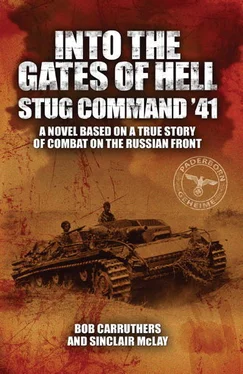Von Schroif paused briefly to assure himself that this vital information was being absorbed. Satisfied that his words were being heeded, he continued with the briefing.
“The infantry must take advantage of the guns’ firepower to advance in strength via pre-arranged lanes not under fire. The assault guns must be given sufficient time for reconnaissance. The guns and the infantry will formulate plans through personal consultation, and will ensure means of communications during battle. Infantry should not stay too close to the guns, and should not bunch. Instead, deployment is advised to lessen the danger of drawing hostile fire and to avoid injury by ricochets. Since the driver of an assault gun has limited vision, infantrymen must keep in mind the danger of being run down, and must move accordingly!”
There was a ripple of amusement at this statement.
“Remember, gentlemen, assault guns are ‘sitting targets’ when they have to wait for the infantry; infantrymen can find cover almost anywhere, but the assault guns cannot. Since the guns fire at the halt, the infantry must gain ground while the guns are firing. Although the assault guns are of great assistance when ground is being gained, it is the infantry that must hold the ground. Since the assault guns must also keep their ammunition available for unexpected or especially dangerous targets, the infantry must engage all the targets that it can possibly take on with its heavy and light weapons. Although the assault guns must withdraw after every engagement to prepare for the next engagement where their assistance will be required, the infantry will not withdraw. Is that clear?”
“Good. Time is short, gentlemen, and you’ll be please to know that we can count on our comrades in the Luftwaffe. Leutnant Vogel is our appropriately named liaison officer. The floor is yours, Leutnant.”
“Thank you, Hauptsturmführer,” said Vogel, stepping forward to take up a position by the map. “Gentlemen, as you are aware, my role is to act as the link between what happens in the skies and with you down below. The system of visual communication between ground troops and aircraft is well developed. It must be remembered, however, that we take the precaution of changing the signals as often as possible. To speed up recognition, ground troops should possess detailed knowledge of our own aircraft types. In this sector you can expect to see the Heinkel 111, the Messerschmitt 109 and our old friend, the Stuka Junkers 87.”
“Can you run through the signals protocol once more?” von Schroif asked, knowing how crucial this information could be.
“Certainly, Hauptsturmführer. In the daytime, ground troops must give recognition signals when air units call for them by giving their own recognition signals, or if friendly aircraft threaten to attack. Orange-coloured smoke is the signal most easily recognised from the air. It means, ‘own troops are here.’ It is the chief recognition signal and should be used by all ground troops wherever possible.”
“I take it everyone is also familiar with the protocols concerning identification panels?” interjected von Schroif.
Without pause, Vogel continued.
“Identification panels are vital. They should be laid out so that they may be read from aircraft flying toward the front. They must be arranged in good time, and on a background against which they can be picked out clearly from the air, so that the aircraft will not be obliged to circle over the battle area. The panels should be spread on open ground, wherever possible, since aircraft usually observe while approaching, and not when directly over a position. Trees, bushes, and other objects may prevent aircraft from seeing the signals obliquely. Every effort must be made to make the signals as large as possible. Panels may be lifted only when the aircraft are out of sight. Yellow cloths mean ‘here is our own frontline.’ They are to be used only for this message, so that the frontline will always be clearly indicated. The aircraft can draw its own conclusions as to the battle situation. In general, yellow is easily recognisable from a moderate height; a number of yellow cloths spread out side by side will make identification easier. When our own troops advance, the yellow cloths must not be left behind! In addition, the orange smoke signal is to be used as extensively as possible.”
“Permission to speak?” The voice was Dirlewanger’s.
Von Schroif was about to refuse when he thought better of the matter. “Granted,” he said, his world-weary tone of voice betraying the grudging manner in which he granted the request.
“In the SS we fly the hooked cross flag. Why not use them?”
“Swastika flags can scarcely be identified at all from great heights,” replied Vogel, “and only with difficulty from moderate heights. Although, if there is no alternative, they obviously mean ‘own troops are here.’ As a rule, they are used in rear positions, but may be used in the frontline if yellow cloths are not available or if no particular value is attached to a distinct recognition of the frontline as such. Since swastika flags alone are generally not sufficient for identification purposes, it is advisable to use the additional signal of orange smoke.”
“And if no smoke is available?” asked Dirlewanger, clearly enjoying his moment.
“If the usual recognition signals are not available, troops may improvise signals, such as the waving of steel helmets, handkerchiefs, and so on. However, these signals afford no guarantee that the ground troops will be recognised.”
“It might be helpful for us to go over the recognition signals which our own aircraft will provide one last time,” interjected von Schroif, now anxious to regain control of the proceedings.
“In the daytime, pilots of all of our aircraft must give recognition signals when fired on by friendly troops. Daytime signals may also be given by aircraft that suddenly emerge from clouds over friendly territory, or that wish to request signals from ground troops. Ground troops will generally be able to identify friendly aircraft by noting the type of plane, the national marking, or special painting. When security permits, messages will be dropped in message boxes that emit a yellow smoke while dropping and after reaching the ground. If these boxes are not available, messages will be dropped in message bags, to which a red and white streamer is attached. Aircraft may improvise such signals as the dipping up and down of the nose and tail of a plane, wing dipping, or repeated spurts of the motor which we call ‘jackrabbiting’.”
“That takes care of the daytime scenario,” stated von Schroif, bringing that section to a close. “Are we all clear on the night signals?”
“Aircraft must give night signals when there is the danger of being attacked by friendly troops. In the forthcoming operation we will use white, green, and red Very lights. White Very lights will be used to request ground troops to give recognition signals: green, when a plane is about to drop a message and wishes ground troops to indicate where they prefer to have it dropped, and red, to convey the message ‘Beware of enemy antitank weapons’, while blue or violet smoke signals will be used to indicate the presence of enemy tanks.”
“Thank you, Leutnant,” said von Schroif, drawing the briefing to a close. “Very comprehensive. Let’s hope we don’t need the blue signals, eh? That will be all, gentlemen, and may good luck stay with you all.”
* * * * *
As the dance finally came to an end and the last drunken remnants edged their way towards their beds, Zubachyov found himself rather smitten. As a result, he had tried hard to get Bettina away from her hefty chaperone and on her own. He had tried very hard and eventually he had succeeded. By taking the longest possible route back to the nurses’ home, he had tired the flagging Anastasia to the point where she had been forced to admit defeat and had reluctantly turned in.
Читать дальше












